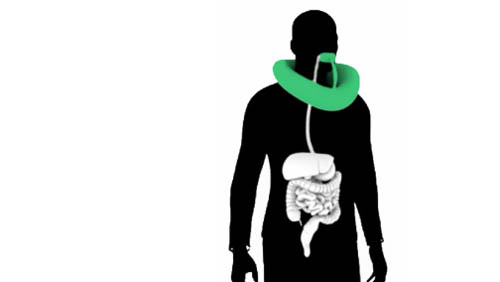 [Image: An augmented-eating apparatus from “Foragers” by Dunne & Raby].
[Image: An augmented-eating apparatus from “Foragers” by Dunne & Raby].
For a project called “Foragers,” design duo Dunne & Raby—who spoke last month at Thrilling Wonder Stories 2—sought a design-based solution to the urgent problem of future food supplies. “The world is running out of food–we need to produce 70% more food in the next 40 years according to the UN. Yet we continue to over-populate the planet, use up resources and ignore all the warning signs,” the designers warn. “It is completely unsustainable.”
Their eventual proposal was not a new type of grain, however, or a more effective cookstove. After all, they point out, “we have not really embraced the power to modify ourselves. What if we could extract nutritional value from non-human foods using a combination of synthetic biology and new digestive devices inspired by digestive systems of other mammals, birds, fish and insects?”
Dunne & Raby thus suggested the wholesale genetic alteration of the human digestive tract, in tandem with the design and adoption of new technical instruments for obtaining food from the larger environment. The human body could thereafter metabolize a highly diverse range of nutrients, from tree branches to algae-filled pond water.
But is this the direction that future food-system design and research should be going?
Nicola Twilley, author of Edible Geography and Food Editor for GOOD, is hosting an interesting question this week as part of the ongoing Glass House Conversations about this very topic. “The design of food has the potential to reshape the world,” Nicola writes, “let alone what we eat for dinner.”
Food—the substance itself, as well as its methods of production and consumption—has always been the subject of tinkering and design. The color of carrots, the shape of silverware, and the layout of supermarkets are all products of human ingenuity applied to the business of nourishment. Today, food is being redesigned more fundamentally and at a faster pace than ever before. This process is taking place in a wide variety of different contexts, with very different goals in mind, from corporate food technologists re-shaping salt crystals to maintain palatability while combating heart disease, to synaesthetic experiences designed by artist-entrepreneurs such as Marije Vogelzang.
Which leads to the week’s question: “In an era when food justice, food security, climate change, and obesity are such pressing issues, should there be public funding for food design R&D, and, if so, who should be receiving it?”
Should the designed future of food, and food systems more generally, be left to private corporations, to public institutions, to university labs, to individual entrepreneurs, to speculative design firms, or to some unexpected combination of all of the above? Further, what specific lines of design exploration should be explored when it comes to the global food supply, whether it’s genetic modification or new forms of preservation? Finally, how should these advances in food be best funded and pursued?
The forum will remain open until 8pm EST on Friday, December 17; be sure to join in, as it should be a good conversation.
